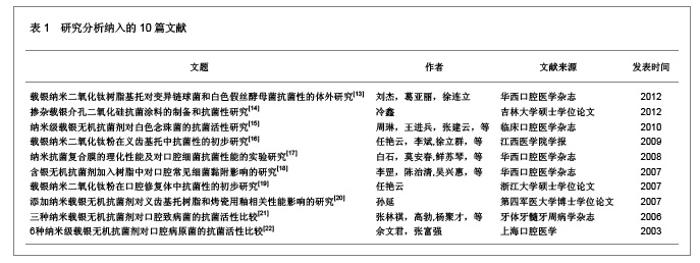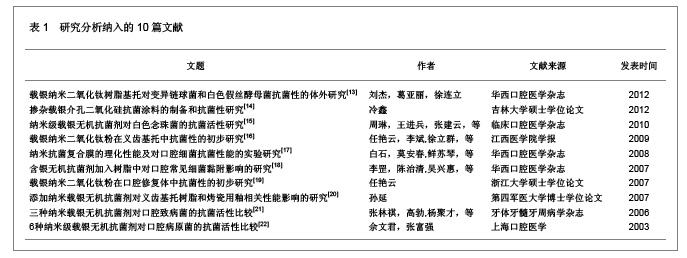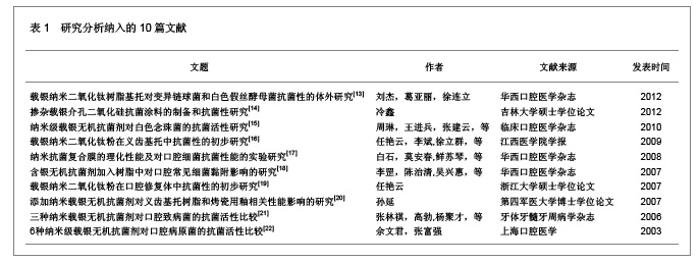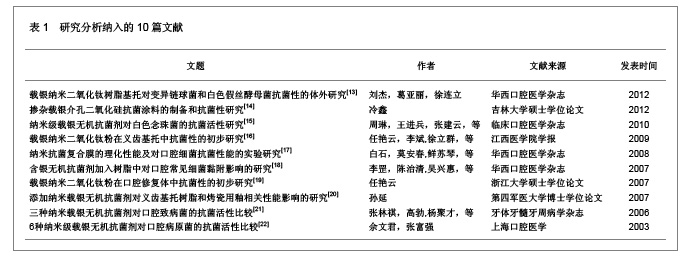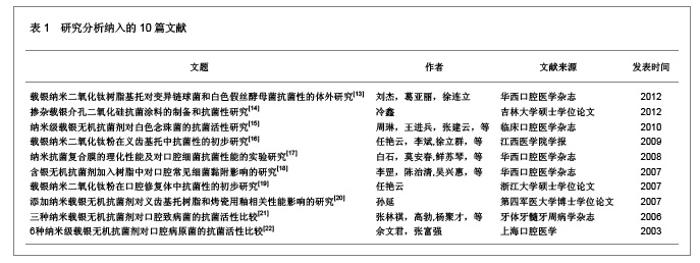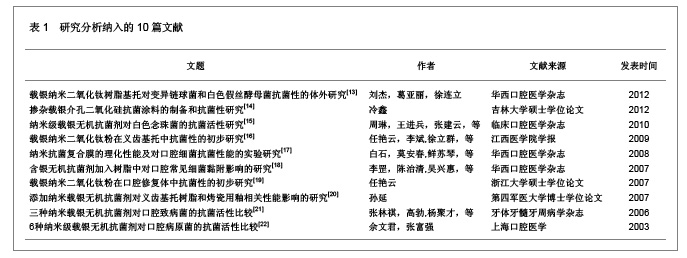| [1] 刘斌,余占海,王丽京,等.可摘局部义齿患者口腔内环境变化的动态观察[J].牙体牙髓牙周病学杂志,2002,12(1):20-22. [2] 余占海,周益民,李燕平.可摘局部义齿基牙牙周指数和牙菌斑细菌相对分布[J].牙体牙髓牙周病学杂志,2000,10(1):28-29.[3] 杨准,杜莉.银系无机抗菌剂在口腔材料中的应用及研究进展[J].中华老年口腔医学杂志,2007,5(4):233-235.[4] Jung WK, Koo HC, Kim KW, et al. Antibacterial activity and mechanism of action of the silver ion in Staphylococcus aureus and Escherichia coli. Appl Environ Microbiol. 2008; 74(7):2171-2178. [5] Li WR, Xie XB, Shi QS, et al. Antibacterial activity and mechanism of silver nanoparticles on Escherichia coli. Appl Microbiol Biotechnol. 2010;85(4):1115-1122. [6] Kourai H, Manabe Y, Yamada Y. Mode of bacteriacidal action of zirconium phosphate ceramica containing silver ions in the crystal structure. J Anitibact Anitifung Agents. 1994;22(10): 595-601.[7] Feng QL, Wu J, Chen GQ, et al. A mechanistic study of the antibacterial effect of silver ions on Escherichia coli and Staphylococcus aureus. J Biomed Mater Res. 2000;52(4): 662-668. [8] Pant HR, Pandeya DR, Nam KT, et al. Photocatalytic and antibacterial properties of a TiO2/nylon-6 electrospun nanocomposite mat containing silvernanoparticles. J Hazard Mater. 2011;189(1-2):465-471. [9] Shameli K, Ahmad MB, Zargar M, et al. Fabrication of silver nanoparticles doped in the zeolite framework and antibacterial activity. Int J Nanomedicine. 2011;6:331-341. [10] Oloffs A, Grosse-Siestrup C, Bisson S, et al. Biocompatibility of silver-coated polyurethane catheters and silver-coated Dacron material. Biomaterials. 1994;15(10):753-758. [11] 刘维良.纳米载银抗菌粉体材料的制备工艺与性能[J].中国陶瓷,2001,37(1):1-3.[12] 中国知网.中国学术期刊总库[DB/OL].2012-12-2. https://www.cnki.net[13] 刘杰,葛亚丽,徐连立.载银纳米二氧化钛树脂基托对变异链球菌和白色假丝酵母菌抗菌性的体外研究[J].华西口腔医学杂志, 2012, 30(2):201-205.[14] 冷鑫.掺杂载银介孔二氧化硅抗菌涂料的制备和抗菌性研究[D].吉林:吉林大学,2012:1-45.[15] 周琳,王进兵,张建云,等.纳米级载银无机抗菌剂对白色念珠菌的抗菌活性研究[J].临床口腔医学杂志,2010,26(9):518-520. [16] 任艳云,李斌,徐立群,等.载银纳米二氧化钛粉在义齿基托中抗菌性的初步研究[J].江西医学院学报,2009,49(12):7-10.[17] 白石,莫安春,鲜苏琴,等.纳米抗菌复合膜的理化性能及对口腔细菌抗菌性能的实验研究[J].华西口腔医学杂志,2008,26(4): 358-361.[18] 李罡,陈治清,吴兴惠,等.含银无机抗菌剂加入树脂中对口腔常见细菌黏附影响的研究[J].华西口腔医学杂志,2007,25(3): 280-284.[19] 任艳云.载银纳米二氧化钛粉在口腔修复体中抗菌性的初步研究[D].浙江:浙江大学,2007:1-62.[20] 孙延.添加纳米载银无机抗菌剂对义齿基托树脂和烤瓷用釉相关性能影响的研究[D].陕西:第四军医大学,2007:1-137.[21] 张林祺,高勃,杨聚才,等.三种纳米载银无机抗菌剂对口腔致病菌的抗菌活性比较[J].牙体牙髓牙周病学杂志,2006,16(5): 254-256. [22] 佘文君,张富强.6种纳米级载银无机抗菌剂对口腔病原菌的抗菌活性比较[J].上海口腔医学,2003,12(5):356-358.[23] 韩秀秀,何文,田修营,等.银系无机抗菌材料抗菌机理及应用[J].山东轻工业学院学报(自然科学版),2010,24(1):25-27.[24] 肖清华,李博文.载银无机抗菌剂的研究现状和发展趋势[J].中国非金属矿工业导刊,1999,(6):5-7.[25] 张文钲,张羽天.载银抗菌材料的研究与开发[J].化工新型材料, 1997,25(7):20-22.[26] 肖耀南,曾汉民,张菊梅,等.金属络合型聚丙烯腈抗菌消臭纤维的结构与性能[J].合成纤维工业,2001,24(4):6-8.[27] Slawson RM, Lee H, Trevors JT. Bacterial interactions with silver. Biol Met. 1990;3(3-4):151-154. [28] Im KC, Takasaki Y, Endo A, et al. Antibacteria lactivity of atype zeolite supporting silver ions indeionized distilled water. Antibact J Antifung Agents. 1996;24(4):269-274. [29] Besinis A, De Peralta T, Handy RD. The antibacterial effects of silver, titanium dioxide and silica dioxide nanoparticles compared to the dental disinfectant chlorhexidine on Streptococcus mutans using a suite of bioassays. Nanotoxicology. 2012. [30] Neelakantan P, Rao CV, Indramohan J. Bacteriology of deep carious lesions underneath amalgam restorations with different pulp-capping materials--an in vivo analysis. J Appl Oral Sci. 2012 ;20(2):139-145. [31] Zhang K, Melo MA, Cheng L, et al. Effect of quaternary ammonium and silver nanoparticle-containing adhesives on dentin bond strength and dental plaque microcosm biofilms. Dent Mater. 2012;28(8):842-852. [32] Cheng L, Zhang K, Melo MA, et al. Anti-biofilm dentin primer with quaternary ammonium and silver nanoparticles. J Dent Res. 2012;91(6):598-604. [33] Valappil SP, Coombes M, Wright L, et al. Role of gallium and silver from phosphate-based glasses on in vitro dual species oral biofilm models of Porphyromonas gingivalis and Streptococcus gordonii. Acta Biomater. 2012;8(5):1957-1965. [34] Chang YY, Lai CH, Hsu JT, et al. Antibacterial properties and human gingival fibroblast cell compatibility of TiO2/Ag compound coatings and ZnO films on titanium-based material. Clin Oral Investig. 2012;16(1):95-100. [35] Liao J, Anchun M, Zhu Z, et al. Antibacterial titanium plate deposited by silver nanoparticles exhibits cell compatibility. Int J Nanomedicine. 2010;5:337-342. [36] Hiraishi N, Yiu CK, King NM, et al. Antimicrobial efficacy of 3.8% silver diamine fluoride and its effect on root dentin. J Endod. 2010;36(6):1026-1029. [37] Juan L, Zhimin Z, Anchun M, et al. Deposition of silver nanoparticles on titanium surface for antibacterial effect. Int J Nanomedicine. 2010;5:261-267. [38] Choi JY, Chung CJ, Oh KT, et al. Photocatalytic antibacterial effect of TiO(2) film of TiAg on Streptococcus mutans. Angle Orthod. 2009;79(3):528-532. [39] Alt V, Bechert T, Steinrücke P, et al. An in vitro assessment of the antibacterial properties and cytotoxicity of nanoparticulate silver bone cement. Biomaterials. 2004;25(18):4383-4391. |
